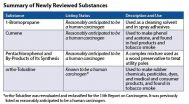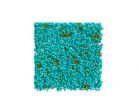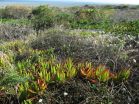(Press-News.org) Four substances have been added in the U.S. Department of Health and Human Services 13th Report on Carcinogens, a science-based document that identifies chemical, biological, and physical agents that are considered cancer hazards for people living in the United States. The new report includes 243 listings.
Ortho-toluidine, used to make rubber chemicals, pesticides, and dyes, has been reevaluated and is now listed as a known human carcinogen. Three substances have been added as reasonably anticipated to be human carcinogens. These include 1-bromopropane, used as a cleaning solvent and spray adhesive; cumene, used to make phenol and acetone, and also found in fuel products and tobacco smoke; and the wood preservative mixture pentachlorophenol.
"Identifying substances in our environment that can make people vulnerable to cancer will help in prevention efforts," said Linda Birnbaum, Ph.D., director of the National Institute of Environmental Health Sciences (NIEHS) and the National Toxicology Program (NTP). "This report provides a valuable resource for health regulatory and research agencies, and it empowers the public with information people can use to reduce exposure to cancer causing substances."
The Report on Carcinogens is a congressionally mandated report prepared for the HHS Secretary by NTP. The report identifies agents, substances, mixtures, or exposures in two categories: known to be a human carcinogen and reasonably anticipated to be a human carcinogen. The new report is available at http://ntp.niehs.nih.gov/go/roc13.
A listing in the report indicates a cancer hazard, but does not by itself mean that a substance will cause cancer. Many factors, including the amount and duration of exposure, and an individual's susceptibility to a substance, can affect whether a person will develop cancer.
One Substance Added as a Known Human Carcinogen
Since 1983, ortho-toluidine has been listed in the Report on Carcinogens as reasonably anticipated to be a human carcinogen. However, new cancer studies led NTP to reevaluate and reclassify ortho-toluidine, and it is now added to the category of known to be a human carcinogen, based on studies in humans showing it causes urinary bladder cancer. Ortho-toluidine is a synthetic chemical produced in other countries and imported into the United States by several companies in high volumes. It is primarily used to make rubber chemicals, pesticides, and dyes. It is also used in some consumer and medical products. People are mainly exposed through the workplace, by skin contact and/or inhalation when using ortho-toluidine. People can also be exposed outside the workplace through sources such as tobacco smoke.
Three Substances Added to the New Report as Reasonably Anticipated to Be a Human Carcinogen
The chemical 1-bromopropane is a colorless to pale yellow liquid used as a solvent in many commercial industries. It is used as a cleaner for optics, electronics, and metals, as well as a solvent for aerosol-applied adhesives such as those used in foam cushion manufacturing. It is also used in dry cleaning and in solvent sprays for aircraft maintenance. Workers in certain occupations may be more exposed to 1-bromopropane than the general population. No human studies were identified that evaluated the relationship between human cancer and exposure specifically to 1-bromopropane. However, inhalation exposure to 1-bromopropane in rodents caused tumors in several organs, including the skin, lungs, and large intestine.
Cumene is a flammable and volatile liquid with a gasoline-like odor. It is a natural component of coal tar and petroleum, and is found in tobacco smoke. It is used primarily to make acetone and phenol. People are mainly exposed to cumene through the environment and in workplaces that use or produce cumene. It can be found in emissions from petroleum products. Inhalation exposure to cumene caused lung tumors in male and female mice, and liver tumors in female mice. No human studies were identified that looked at the relationship between human cancer and exposure specifically to cumene.
Pentachlorophenol and by-products of its synthesis are complex mixtures of chemicals used as wood preservatives. Because virtually everyone who is exposed to pentachlorophenol is also exposed to its synthesis by-products, they were evaluated together. In the United States, pentachlorophenol has been regulated since the 1980s as a restricted-use pesticide. It is used industrially for treating utility poles, wood pilings, fence posts, and lumber or timber for construction. Most exposure has occurred in settings where workers treat lumber or come in contact with treated lumber. People may also be exposed to this mixture from breathing contaminated air or dust, or from contact with contaminated soil. Exposure to this mixture was associated with an increased risk of non-Hodgkin lymphoma in studies in humans. It also caused tumors in the liver and other organs in mice.
INFORMATION:
The Report on Carcinogens, 13th Edition, is prepared by the National Toxicology Program (NTP). NTP is a federal, interagency program, headquartered at the NIEHS, whose goal is to safeguard the public by identifying substances in the environment that may affect human health. For more information about NTP and its programs, visit http://ntp.niehs.nih.gov/.
NIEHS supports research to understand the effects of the environment on human health and is part of NIH. For more information on environmental health topics, visit http://www.niehs.nih.gov. Subscribe to one or more of the NIEHS news lists to stay current on NIEHS news, press releases, grant opportunities, training, events, and publications.
About the National Institutes of Health (NIH)
NIH, the nation's medical research agency, includes 27 Institutes and Centers and is a component of the U.S. Department of Health and Human Services. NIH is the primary federal agency conducting and supporting basic, clinical, and translational medical research, and is investigating the causes, treatments, and cures for both common and rare diseases. For more information about NIH and its programs, visit http://www.nih.gov.
When asked to describe a forest or a meadow, most people would probably begin with the plants, the species diversity, or the color of the foliage. They probably wouldn't pay much attention to the animals living in the soil.
But a new Yale-led study shows the critical importance of earthworms, beetles, and other tiny creatures to the structure of grasslands and the valuable ecosystem services they provide.
During a 3-year study, researchers found that removing these small animals from the soil of a replicated Scottish sheep meadow altered the plant species that grew ...
LOS ANGELES – (Oct. 2, 2014) – Surveying patients with traumatic brain injuries, a group of Los Angeles Biomedical Research Institute (LA BioMed) researchers reported today that they found those who tested positive for THC, the active ingredient in marijuana, were more likely to survive than those who tested negative for the illicit substance.
The findings, published in the October edition of The American Surgeon, suggest THC, or tetrahydrocannabinol, may help protect the brain in cases of traumatic brain injury, the researchers said. The study included 446 patients who ...
New Rochelle, NY, October 2, 2014–Women who have a history of violent sexual abuse may suffer emotional distress during a routine pelvic examination. Healthcare providers would benefit from greater awareness of symptoms predictive of examination-related distress in this patient population, according to a study published in Violence and Gender, a new peer-reviewed journal from Mary Ann Liebert, Inc., publishers. The article is available free on the Violence and Gender website at http://online.liebertpub.com/doi/full/10.1089/vio.2014.0016 until November 2, 2014.
In the ...
VIDEO:
Researchers from the University of Pennsylvania and the University of California, Santa Barbara, have now shown how giant clams use iridescent structures to thrive, operating as exceedingly efficient, living greenhouses...
Click here for more information.
Evolution in extreme environments has produced life forms with amazing abilities and traits. Beneath the waves, many creatures sport iridescent structures that rival what materials scientists can make in the laboratory.
A ...
PHILADELPHIA, PA – Physicians have long speculated at the hard-to-treat nature of joint infection. In an article published in Journal of Infectious Diseases, Thomas Jefferson University scientists, in collaboration with scientists at the National Institutes of Health, come one step closer to understanding why these infections are so tough to tackle. The results could help explain the joint pain caused by different infections, including Lyme disease and why they're so resistant to antibiotic treatment.
"Biofilm formation has been suspected to play a key role during septic ...
New research suggests treatment in Australia and New Zealand for patients with sepsis is the best in the world.
The large-scale six-year study, led by the Australian and New Zealand Intensive Care Research Centre at Monash University, divided 1600 patients into two groups, who were admitted to emergency care with early stage sepsis from across more than 40 hospitals.
The first group of 796 patients received Early Goal Directed Therapy (EGDT), an aggressive treatment not currently used in Australia and New Zealand, which inserts a catheter into the jugular vein to monitor ...
Published today in PLOS ONE, the study is the first in the world to show that it is possible to predict abstract judgments from brain waves, even though people were not conscious of making such judgments.
The study also increases our understanding of impulsive behaviours and how to regulate it.
It found that researchers could predict from participants' brain activity how exciting they found a particular image to be, and whether a particular image made them think more about the future or the present.
This is true even though the brain activity was recorded before ...
PROVIDENCE, R.I. [Brown University] — Dov Sax of Brown University and Jason Fridley of Syracuse University aren't proposing a novel idea to explain species invasiveness. In fact, Charles Darwin articulated it first. What's new about Sax and Fridley's "Evolutionary Imbalance Hypothesis" (EIH) is that they've tested it using quantifiable evidence and report in Global Ecology and Biogeography that the EIH works well.
The EIH idea is this: Species from regions with deep and diverse evolutionary histories are more likely to become successful invaders in regions with less deep, ...
Molecular studies of plants often depend on high-quantity and high-quality DNA extractions. This can be quite difficult in plants, however, due to a diversity of compounds and physical properties found in plants. "Tannins, tough fibrous material, and/or secondary compounds can interfere with DNA isolation," explains Dr. Thomas Givnish, principal investigator of a new study published by Jackson Moeller et al. in the October issue of Applications in Plant Sciences (available for free viewing at http://www.bioone.org/doi/pdf/10.3732/apps.1400048).
This is further complicated ...
WASHINGTON, Oct. 2, 2014—Commercial devices capable of encrypting information in unbreakable codes exist today, thanks to recent quantum optics advances, especially the generation of photon pairs—tiny entangled particles of light. Now, an international team of researchers led by professor Roberto Morandotti of INRS-EMT in Canada, is introducing a new method to achieve a different type of photon pair source that fits into the tiny space of a computer chip.
The team's method, which generates "mixed up" photon pairs from devices that are less than one square millimeter ...




